Dartford Council Light Railways
History
In 1901, Dartford Urban District Council and its close neighbours, Dartford Rural District Council and Bexley Urban District Council, promoted a scheme for a standard-gauge, overhead electric tramway running from Woolwich in the west of Kent to Dartford in the east. Although Bexley UDC quickly obtained powers (on the 26th July 1901) to construct their portion of the scheme, the two Dartford councils ran into problems, firstly because a Tramway Order could not by law be granted to a rural district council, and secondly, as a result of vociferous opposition (from the South Eastern and Chatham Railway Company) to their subsequent application for a Light Railway Order. In the end, an LRO was granted — on the 6th February 1902 — to Dartford UDC, Dartford RDC having withdrawn from the scheme.
Further powers were obtained on the 13th November 1903 for an eastward extension of the line from Dartford to Horns Cross, though the original objective of Gravesend had to be shelved due to the objections of the SECRCo. Construction started at the boundary with Bexley on the 12th July 1905, and the system was ceremonially opened seven months later on the 14th February 1906. The contractor — J G White and Company — also agreed to operate the tramway under a lease arrangement, initially for 5 years, then renewable at 5-year intervals.
The Dartford system comprised a main line running west to east, with two short branches within Dartford, in total of 6.55 route miles. From the Bexley boundary at Gravel Hill, the line ran southeastwards through Crayford and Dartford to The Brent, whereupon it turned northeastwards to a terminus outside 'The Bull' in Horns Cross. Within Dartford itself, a short line branched off opposite 'The Bull Hotel' to the station, after which it turned northwestwards along Victoria Road to the tram depot; the other branch ran southwards just after 'The Bull Hotel', along Lowfield Street to a terminus at Oakfield Lane, somewhat short of the destination shown on the tramcars, Wilmington.
Despite having promoted a joint tramway scheme, Bexley UDC now refused to allow a connection to be put in at Gravel Hill, being more than happy for any through passengers to be turfed out at the municipal boundary, which by definition was on the edge of town. Bexley's position was, frankly, perverse, doubly so considering that its tramway was running at a loss. After much ridicule in the local press, the council finally altered its stance, allowing a connection to be put in at Gravel Hill, Dartford tramcars running through to Bexleyheath Market Place from the 27th August 1906.
In 1909, J G White and Company handed over operation of both its leased tramways — Dartford Council Light Railways, and Luton Corporation Tramways — to Balfour Beatty and Company, which had been set up on the 12th January that year by two of its former employees, George Balfour and Andrew Beatty. Following assurances from the company, the council agreed to the transfer, and seems to have been happy with the service provided, given that it twice renewed the operating lease.
Bus competition first appeared in 1913 in the form of North Kent Motor services, a subsidiary of Gravesend and Northfleet Electric Tramways Limited, which was itself a subsidiary of the British Electric Traction Company. These buses competed directly with the trams between Horns Cross and Dartford, though the advent of the Great War greatly reduced this. The Great War also brought greatly increased loadings, principally to the Vickers works at Crayford, but also to various munitions factories in the area. To support the increased loadings, Bexley UDC tramcars were allowed to work through to Crayford, though the two councils soon fell out over payments, the disagreement ultimately being resolved in Bexley's favour (at arbitration).
Disaster struck the tramway in the early hours of Tuesday 17th August 1917 when a fire broke out in the tram depot, destroying the entire tramcar fleet of 13 vehicles. Bexley UDC came to the rescue, starting an emergency service the following day (8th August 1917) with as many tramcars as it could spare. These were soon joined by 12 second-hand vehicles hired from London County Council Tramways (these were bought by Bexley in August 1918), supplemented with six more hired in.
On the 25th February 1919, an agreement was signed between Dartford UDC and Bexley UDC for the latter to work the two tramways as a single system until the 31st March 1921, which was the expiry date of the BB&Co lease. A new agreement was struck on the 5th February 1922, which was backdated to the 1st April, for both systems to be worked as a single entity under the auspices of the Bexley Urban District Council Tramways and Dartford Light Railways Joint Committee. Bexley were to provide all tramcars and staff.
By this time, however, both tramways were in trouble, passenger numbers having fallen away significantly, whilst the track and tramcars were all in poor condition. A deficit of £8000 in 1923 meant that there was little chance of money being found to set the system in order, second-hand rails being about the only measure taken to improve matters. All this may well have been avoided if both councils had not seen fit, in 1921, to reject proposals for London County Council Tramways to take over operation, a scheme to which neighbouring Erith UDC was positively disposed.
Towards the end of the 1920s, the relationship between the two councils deteriorated markedly, Bexley claiming that its system made a profit, which was then offset by losses incurred in working the Dartford system. Bexley not unnaturally wanted to see this state of affairs rectified through increased payments from Dartford, which the latter steadfastly refused to countenance. As a result, Bexley formally served notice on Dartford — on the 7th October 1932 — that it would withdraw from the agreement 12 months hence. However, this eventuality never came to pass, both systems, along with 12 others being subsumed into the London Passenger Transport Board on the 1st July 1933.
The last tram of all over former Dartford Council Light Railways tracks — operated by the LPTB — ran on the 23rd November 1935, tram services being withdrawn in favour of trolleybuses and motorbuses.
Uniforms
High quality photographs of Dartford tramcar crews have so far proved impossible to find, so a description of the uniforms and insignia they wore, is per force superficial. Early images suggest that both motormen and conductors wore double-breasted, lancer-style tunics with five pairs of buttons (narrowing from top to bottom, and of an unknown pattern, though possibly plain with a scalloped rim), epaulettes and stand-up collars; the latter probably bore badges of some kind, possibly the lessee company's initials and employee numbers. The tensioned-crown peaked caps bore standard, off-the-shelf, script-lettering grade badges, 'Motorman' or 'Conductor'. It is currently unclear whether the buttons and badges were brass or nickel.
At some point prior to the Great War, conductors' jackets were changed to a single-breasted design with five buttons, two breast pockets (with button closures), epaulettes and stand-up collars.
Motormen (and possibly conductors too) were also provided with heavy-duty, double breasted greatcoats with five pairs of buttons, epaulettes and high, fold-over collars; they appear to have been completely devoid of insignia.
Motormen and conductors always appeared in service wearing enamel Public Carriage Office licence badges (see link), which were issued by the Metropolitan Police.
Whilst photographs of inspectors are yet to come to light, a single photograph of a chief inspector has survived. The subject is wearing typical 'tramway inspector' garb, which by extrapolation, was probably also worn by his junior colleagues. Inspectors' jackets were probably, therefore, single-breasted and edged in material of a finer quality than the main garment, with hidden buttons (or more likely a hook and eye affair), and stand-up collars; the latter probably bore the grade — 'Inspector' — in embroidered script lettering. The caps were probably of the tensioned-crown, peaked variety, and would have also borne the grade in embroidered script lettering on a hat band.
The chief inspector's' jacket collars bore the grade — 'Chief Inspector' — in embroidered script lettering over two lines. The tensioned-crown peaked caps also bore the grade — 'Chief Inspector' — in embroidered script lettering, but over one line, and on a brocade hat band. The chief inspector (and probably ordinary inspectors too) were also provided with double-breasted overcoats with lapels; the collars carried the bearer's grade in embroidered script lettering (over two lines in the case of the chief inspector).
In common with the majority of UK tramway systems, Dartford employed female staff during the Great War — probably as conductresses only — to replace men lost to the armed surfaces. Only two photographs are known to have survived, both of which were taken relatively early on in the conflict, i.e., September and October 1916. Both show conductresses wearing what is clearly informal attire, possibly because uniforms had yet to be issued. Details of the actual uniforms, assuming that the ladies were indeed eventually provided with them, must await the discovery of new photographic evidence.
Further reading
For a history of Dartford's tramways, see: 'Tramways of Woolwich and South-East London' by SOUTHEASTERN; Light Railway Transport League (1963).
Images
Motormen and conductors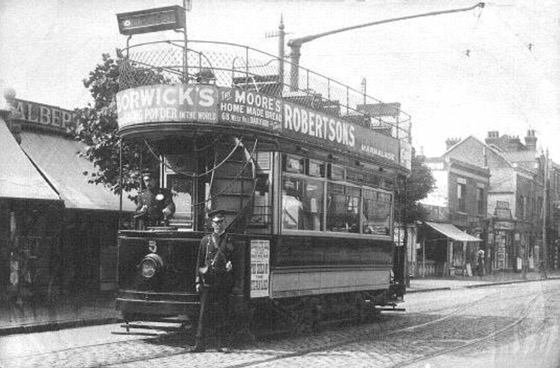
Tramcar No 5 and crew pose for the camera in Bexleyheath Market Place — photo undated, but certainly taken on or after the 27th August 1906, when through-running to Bexleyheath commenced. Both crew members are wearing double-breasted, lancer-style tunics, from which their enamel PCO licence badges (see link) are suspended. Photo courtesy of the Tramways and Light Railway Society.
Standard off-the-shelf, script-lettering grade badges of the type used by Dartford Council Light Railways on tramcar crew caps — brass. Author's Collection.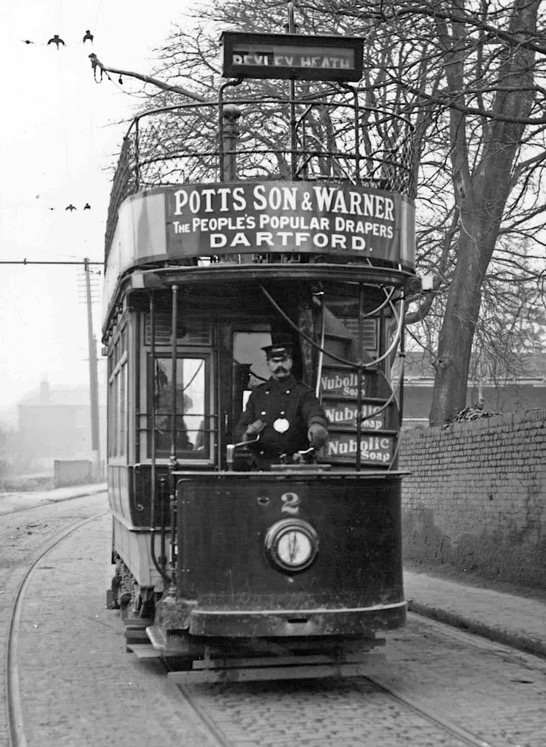
Tramcar Number 2 and motorman at the passing loop at Crayford — photo undated, but probably taken around 1910. Photo courtesy of the Robert Harley Collection.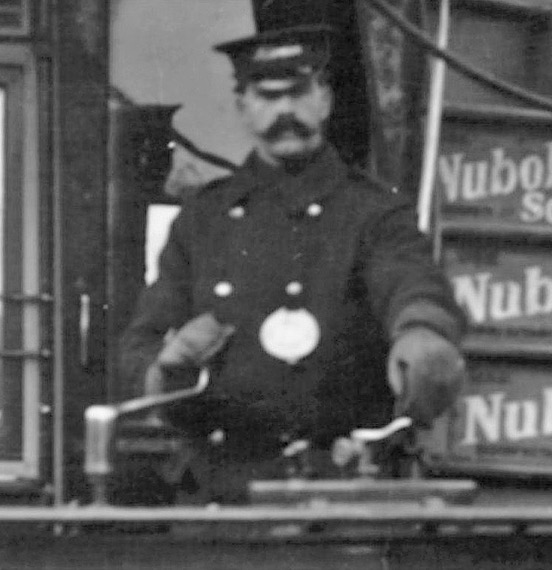
An enlargement of the above photograph showing the motorman, who was known as 'The Flying Dutchman', probably because he or his family hailed from the Netherlands. Although he is wearing a script-lettering grade badge on his cap, his greatcoat is entirely plain, i.e., devoid of insignia.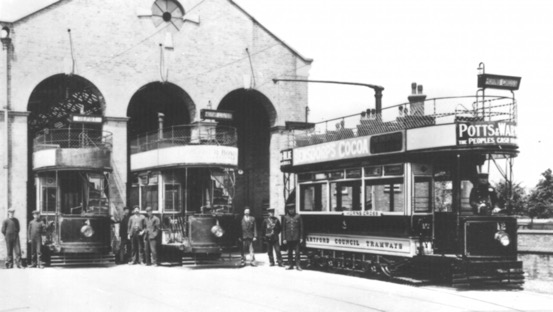
Dartford depot with Tramcars Nos 4, 1 and 12 — purportedly taken on the 4th January 1912. Photo courtesy of the Tramways and Light Railway Society.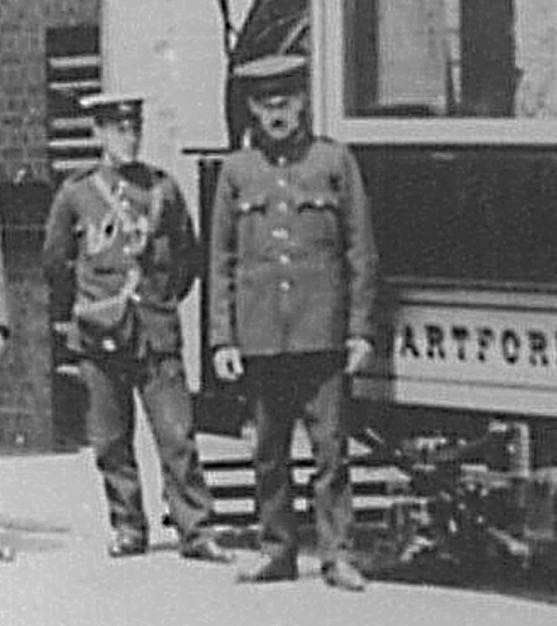
An enlargement of the above photograph showing two members of staff, the man on the left clearly being a conductor.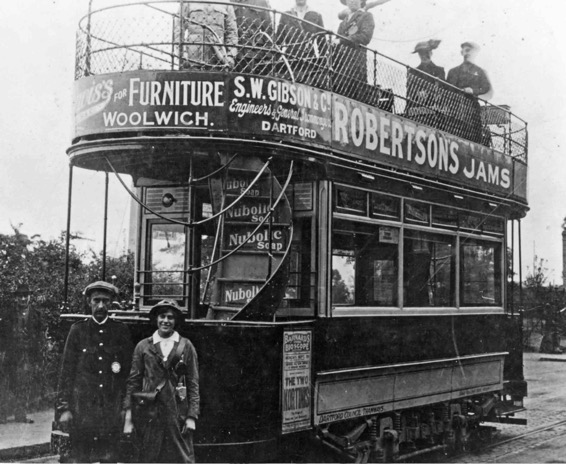
A photograph taken at what is probably Horns Cross, which judging from the poster, was possibly taken in the last week of September 1916. Photo courtesy of the Robert Harley Collection.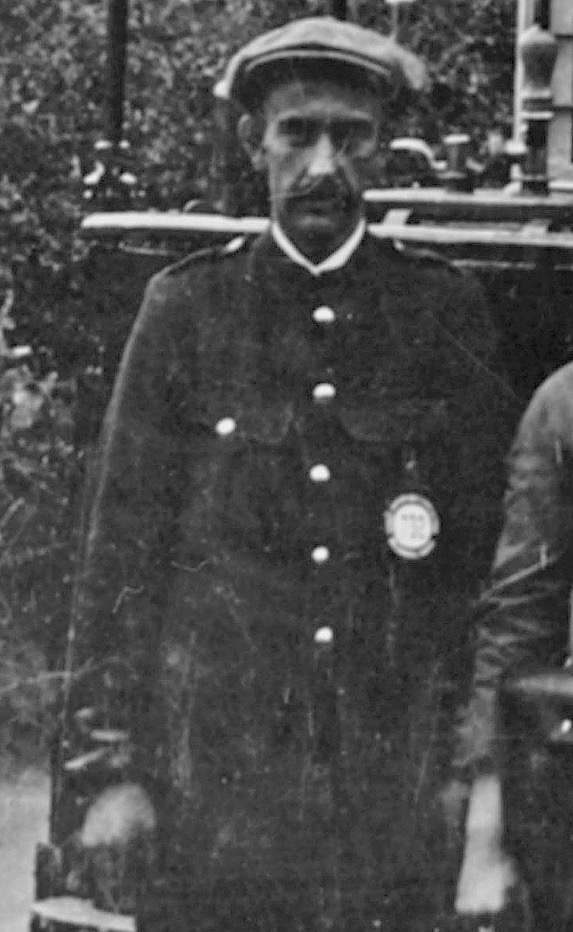
An enlargement of the above photograph showing the motorman; although he is clearly wearing a uniform jacket and a Public Carriage Office licence badge (possibly No 732), his headwear is informal, namely, a flat cap. The subject is wearing a single-breasted jacket rather than the double-breasted, lancer-style tunics that had hitherto been issued to motormen.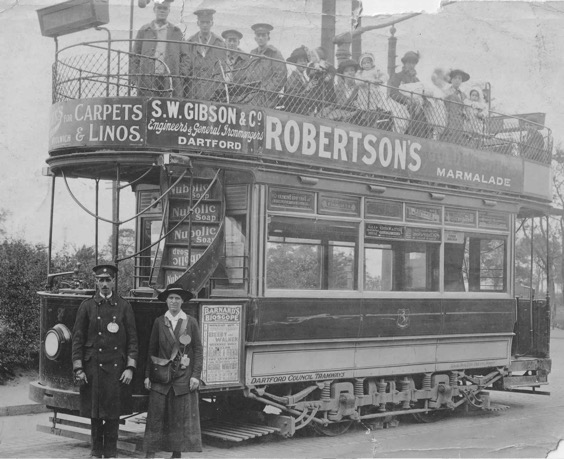
A rare dateable shot of a DCLR tramcar, courtesy of the poster for Barnard's Imperial Bioscope, Dartford, which indicates that the photograph was taken in early October 1916; the location is believed to be Horns Cross. Author's Collection.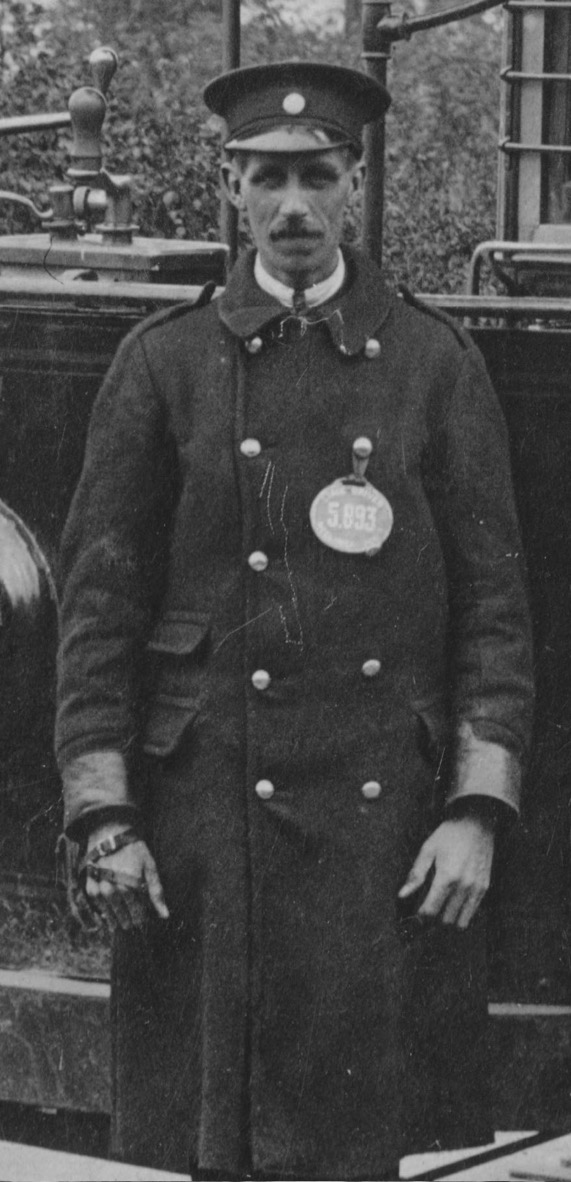
An enlargement of the above photograph showing the motorman, holder of Public Carriage Office 'Stage Driver Mechanical Power' licence badge No 5,893, which would have been white (letters and numbers) on a dark blue background. It is doubtful whether the cap badge was an issue of the tramway, as no other photos show this badge; in all probability it was either an 'ON WAR SERVICE' badge or a military badge, the wearing of regimental badges being common practice amongst tramway men and women during the Great War. The greatcoat buttons would appear to be of the scalloped-rim variety, a type that was favoured by the tramway lessees, Balfour Beatty and Company.
Senior staff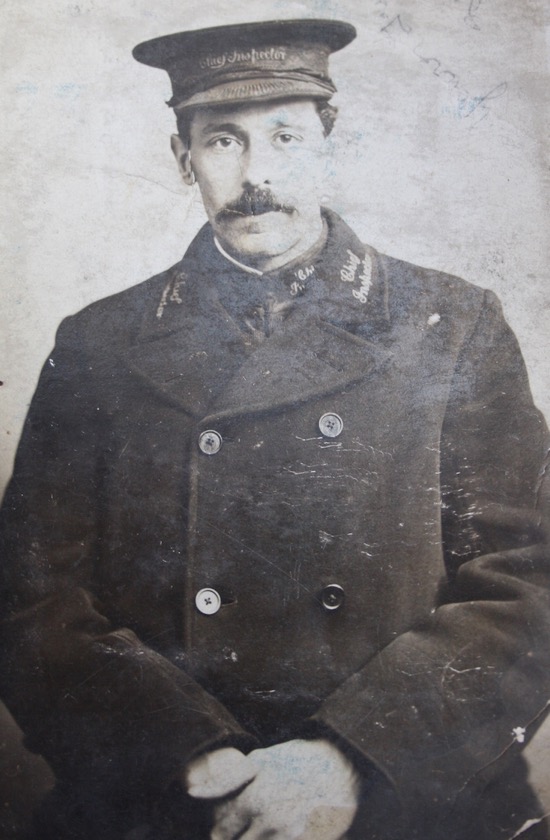
Chief Inspector Samuel Dack — photo undated, but probably taken in 1916 as the postcard was intended for his brother who was killed in August of that year, so was never sent. Although we cannot be absolutely certain that he was an employee of the DCLR (Bexley is very near by), in view of the fact that he was living in Conley Road, Dartford, in 1911, and remained there all his life, it seems a reasonable assumption to make. Samuel eventually retired from the Operating Manager's Department of Central Road Services on 26th July 1949 after 43 years service, strongly suggesting that he started with the DCLR in 1906. Photo with kind permission of Linda Reed, Samuel's Great Grand-daughter.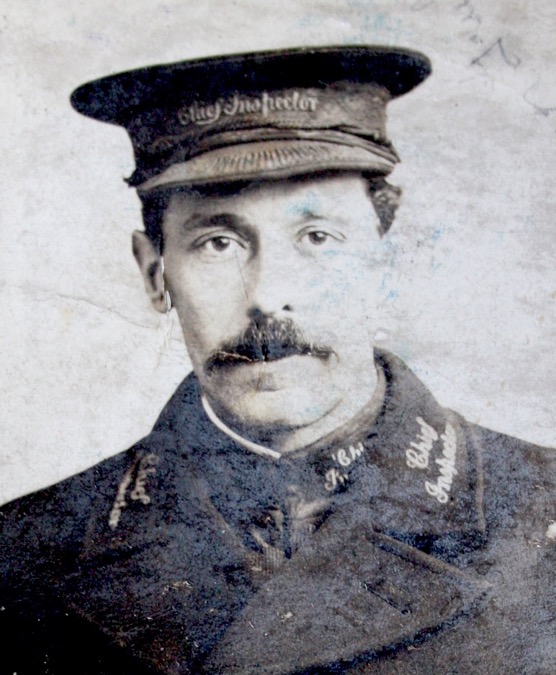
A blow-up of the above photograph showing the collar and cap insignia.
Female staff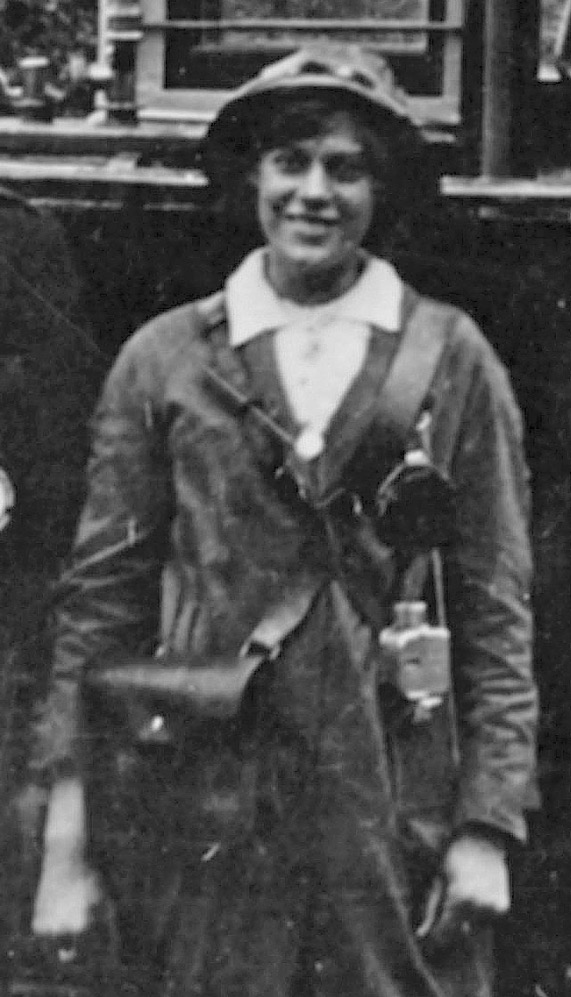
An enlargement of the photograph above, possibly taken in September 1916, showing the conductress. The subject is clearly wearing informal attire, the only badge of office being the PCO licence badge suspended from a button on her jacket.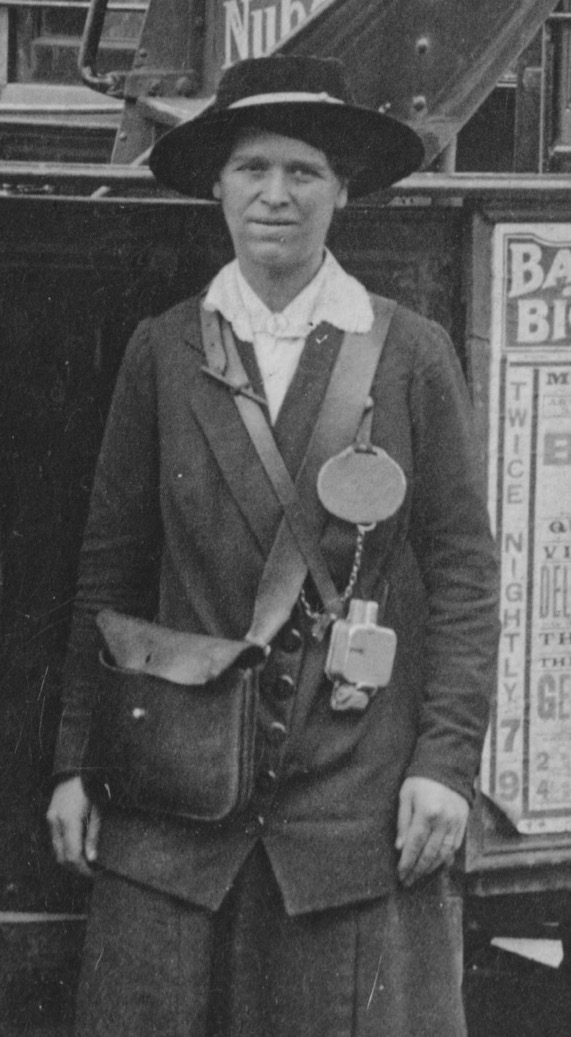
An enlargement of the October 1916 photograph above, showing the conductress. Once again, the subject is wearing informal attire, with a PCO licence badge suspended from a button on her jacket.